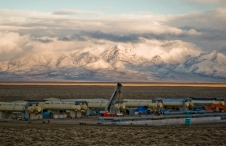Brady's Hot Springs
Brady's Hot Springs is located along the southeast side of U.S. Interstate 80 about twenty miles northeast of Fernley, Nevada. These are the Emigrant Springs of the Forty-Mile Desert described by early transients in the mid-1800s, and they have been variously referred to as Hot Springs, Brady's, Springer's, or Fernley Hot Springs. The area is currently utilized for geothermal power exploration and development and agricultural processing.
Early travelers called it the Spring of False Hope. Coming across the desert, the oxen of the wagon trains smelled the moisture before reaching the springs and rushed forward to drink the scalding water. The emigrants collected water in casks to cool for later use, but pushed on to the Truckee River, as there was no livestock forage at the springs.
In the 1880s, an observer reported hot boiling water issuing from a number of orifices, accompanied by steam and a hissing and roaring sound. Development efforts during this period included an unsuccessful attempt to separate boric acid from the waters; later the hot water was used in a bathhouse and swimming pool associated with a service station along U.S. Highway 40. The concrete pool built in 1929 is all that remains today. The hot springs do not flow at the surface today, although on cool mornings, steam vents can be seen from the Interstate.
Magma Power Company drilled geothermal exploration wells in the late 1950s and early 1960s with subsequent cessation of the surface springs in the area. The original spring temperature was 180 F, and boiling water reportedly stands at twenty feet below the surface in one well. By 1979, twelve major geothermal wells had been drilled at Brady's, ranging in depth from 341 feet to almost 1.4 miles, with temperatures up to 417 F. Thermal fumarole activity appeared for three miles along the Brady fault following exploratory drilling, probably due to the drawdown of cooler, near-surface groundwater to deeper areas of hotter rock following the drilling. A similar line of fumaroles developed after a well blowout in 1978, and when drawdown occurs during production, they too can be observed along the Brady fault.
After continued exploration drilling in the 1980s, Western States Geothermal Company brought the Brady's double flash power plant on line in 1992, producing 21 MW from a 367 F resource. The plant was purchased by ORMAT Nevada, Inc. in July 2001, and in 2002 a new 5 MW binary unit was constructed using pentane as the working fluid. Seven geothermal production wells at depths of 1,309 feet to 1.1 miles penetrate permeable zones in tertiary volcanic rocks in the hanging wall of the Brady's fault.
In 1977, Geothermal Food Processors, Inc. of Reno received a $2,836,800 federally guaranteed loan to construct a geothermal food dehydration plant at Brady's, which is still in operation today, demonstrating the versatility and viability of the area's geothermal potential.
Article Locations
Related Articles
Further Reading
None at this time.


